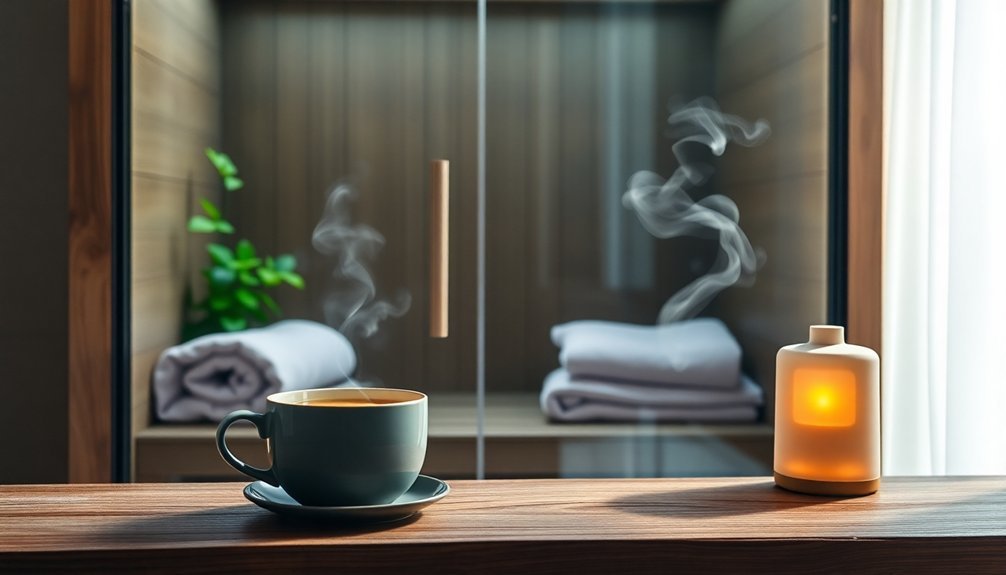Heat therapy can be a game-changer for managing depression, especially when traditional treatments aren't enough. It raises your body temperature and activates brain pathways that help regulate mood, primarily by boosting serotonin levels. You can try various methods like infrared saunas, hot baths, or hot yoga, each providing unique benefits. Sessions should ideally be scheduled bi-weekly, maintaining a core temperature around 101.3°F for about 90 minutes. Always monitor how you feel during therapy and choose safe, comfortable equipment. Keep going, and you'll discover even more tips and options to optimize your heat therapy experience.
Understanding Heat Therapy

Heat therapy, as a promising alternative treatment for depression, can provide significant relief when conventional methods fall short. This approach involves various techniques, primarily whole-body hyperthermia (WBH). You might experience WBH in an infrared sauna or specialized devices designed to heat your body, excluding your head. Traditional methods like Finnish sauna bathing and Native American sweat lodges also fall under this umbrella.
Typically, you'd engage in WBH sessions about every other week, often paired with cognitive-behavioral therapy (CBT). Each session heats your body to a mild fever-like temperature, roughly 101.3°F, for about an hour and a half. The controlled environment, whether a sauna or tent, guarantees an ideal setting for treatment. Research indicates that WBH has been used historically across cultures for various health benefits.
After heating, there's a cooling period that allows your body to return to normal temperature.
Clinical evidence shows that WBH can lead to notable reductions in depressive symptoms. Many participants report improved mood and sustained relief for weeks after a single session.
As you explore this treatment, you'll find WBH offers a non-pharmacological option, making it an appealing choice for those looking to avoid medication.
Mechanism of Action
When you undergo heat therapy, your body temperature increases, which triggers specific brain activation patterns associated with mood regulation. This rise in temperature also influences neurotransmitter regulation, boosting serotonin levels, a key player in fighting depression. Understanding these mechanisms helps explain how heat therapy can provide relief from depressive symptoms. Furthermore, whole-body heating has been shown to activate serotonin-synthesizing neurons, which may enhance the antidepressant effects of the treatment.
Body Temperature Increase
Elevating your body temperature through therapies like whole-body hyperthermia may play an essential role in alleviating depression symptoms. Research shows that individuals with depression often have higher body temperatures compared to those without. A study involving over 20,000 participants found a direct link: as depression symptoms increased, so did body temperature. This correlation suggests that body temperature might serve as a biomarker for depression severity.
When you heat your body to a mild fever level (99.5-101.3°F), it can trigger beneficial changes. A single session can offer relief for up to six weeks. Increased body temperature activates your self-cooling mechanisms, such as sweating, which can eventually lower your temperature more effectively than direct cooling methods. In particular, ongoing research is exploring the role of inflammation and thermosensory pathways in this relationship.
This reaction additionally engages thermosensory pathways, connecting sensory input from your skin to your central nervous system. The antidepressant effect isn't merely a placebo; meaningful differences in outcomes have been observed between authentic heat therapy and sham treatments.
Implementing heat therapies, like hot yoga or infrared saunas, can potentially provide a complementary approach to traditional antidepressant medications, making it a promising option for managing depression.
Brain Activation Patterns
Research into the brain activation patterns associated with heat therapy reveals how this method can benefit those experiencing depression. When you apply heat, it stimulates pathways in your skin that activate key brain areas, particularly the anterior cingulate cortex (ACC) and anterior insula.
The ACC, tied to mood elevation and emotional processing, helps integrate bodily sensations with emotional responses, enhancing how you feel overall. In cases of depression, the typical activity flow can reverse, highlighting the importance of engaging these regions through heat therapy.
The anterior insula also plays a critical role by sending and receiving signals that contribute to how you sense emotional and physical states. As warmth reaches your skin, it's not just activating these areas; it's also stimulating the raphe nucleus, which releases serotonin to improve mood.
This combination of activated brain regions can help reset your mental state, making heat therapy a powerful tool against depressive symptoms. Other cortical regions may also show increased activity, further supporting the mood-enhancing effects of heat therapy, making it a potential alternative or complement to traditional treatments.
Neurotransmitter Regulation
Heat therapy plays an essential role in neurotransmitter regulation, especially concerning serotonin, a key neurochemical linked to mood balance. When you undergo whole-body hyperthermia, your brain synthesizes more serotonin, mimicking the effects of traditional antidepressants. Specifically, the raphe nucleus, responsible for serotonin release, gets activated through the skin-to-brain thermoregulatory pathway. This surge in serotonin contributes to a brighter mood and diminishes depressive symptoms.
Additionally, heat therapy enhances the production of other critical neurotransmitters and hormones that support overall brain health:
| Neurotransmitter/Hormone | Key Effects |
|---|---|
| Brain-Derived Neurotrophic Factor (BDNF) | Promotes neurogenesis; boosts learning and memory |
| Beta-Endorphins | Increases feelings of happiness; reduces pain |
| Norepinephrine | Enhances focus, vigilance, and mood |
The rise in these neurochemicals during heat therapy supports not just immediate mood improvements but may also lead to long-lasting changes in brain function. For anyone struggling with depression, heat therapy offers a promising avenue for enhancing neurotransmitter regulation naturally.
Clinical Evidence and Outcomes

When you look at the study findings on whole-body hyperthermia (WBH), you'll notice it has a significant antidepressant effect compared to a sham procedure, with many participants experiencing symptom relief within just a week.
Impressively, that relief doesn't just fade away; it often lasts up to six weeks after treatment.
This opens up a conversation about the long-term benefits you can expect when utilizing heat therapy for depression.
Study Findings Overview
In exploring the potential of heat therapy for depression, you'll find compelling clinical evidence highlighting its effectiveness alongside traditional cognitive-behavioral therapy (CBT).
Studies focused on patients with major depressive disorder (MDD) who underwent whole-body hyperthermia (WBH) combined with weekly CBT sessions. Participants reported that this integrated mind and body approach was both feasible and acceptable, with low dropout rates indicating strong engagement.
Results showed significant reductions in depressive symptoms, often surpassing expectations from CBT alone. When compared to sham treatments, WBH demonstrated a greater antidepressant effect, confirming that its benefits weren't merely due to placebo.
The Hamilton Depression Rating Scale (HDRS) indicated improvements with mean score changes of 5.67 points at week one and 4.83 points after six weeks, translating to 60% response and 40% remission rates.
The studies utilized rigorous designs, including randomized, double-blind trials, which guarantee robust findings. Additionally, participants experienced mild adverse effects, suggesting the treatment is safely tolerated.
With these results, you can see how heat therapy could be a beneficial addition to your depression management plan.
Long-term Benefits Observed
Numerous studies demonstrate the long-term benefits of whole-body hyperthermia (WBH) for individuals dealing with depression. After just one treatment, many experience symptom reduction lasting up to six weeks. You'll likely notice significant drops in Hamilton Depression Rating Scale (HDRS) scores, remaining stable even after several weeks. In fact, about 60% of participants respond positively, and 40% can achieve remission.
WBH's advantages stand out, especially when combined with cognitive-behavioral therapy (CBT). Those receiving this combo show even more substantial progress, as nearly all patients no longer met criteria for major depressive disorder after treatment.
You might appreciate the practicality of WBH; participants felt confident they received effective care, even in studies involving sham treatments. Mild side effects were noted but didn't deter people from sticking with the sessions.
Additionally, WBH triggers brain activation that promotes serotonin synthesis, similar to conventional antidepressants. This means it could engage areas in your brain focused on mood regulation.
Though research is ongoing, early findings suggest WBH offers a promising avenue for managing depression effectively and sustainably.
Types of Heat Therapy
Exploring various types of heat therapy can uncover effective methods for alleviating symptoms of depression. One popular option is whole-body hyperthermia, often achieved using an infrared sauna dome. During a session that lasts about 107 minutes, your core body temperature can raise to 38.5°C (101.3°F). This method can enhance mood, especially when paired with cognitive-behavioral therapy (CBT).
Another alternative is hyperthermic baths, where immersing your body in hot water raises your temperature and stimulates the release of beneficial heat shock proteins. While this method may require specific facilities, it can serve as a complementary treatment to sauna therapy.
Hot yoga offers another approach, blending physical postures and breathwork with high temperatures. The combination of movement and heat can boost your mood and reduce depressive symptoms. However, it's crucial to evaluate your physical readiness for such intense practice.
Lastly, traditional sweat lodges provide intense heat and communal support. This cultural practice may promote emotional well-being while mimicking the effects of whole-body hyperthermia.
Each type has unique benefits, so you might find one that resonates with you.
Using Infrared Saunas

Infrared saunas offer a powerful tool for tackling symptoms of depression and enhancing overall mental well-being. When you step into an infrared sauna, you're harnessing heat to optimize the production of key neurotransmitters like dopamine, norepinephrine, and serotonin—natural antidepressants essential for mood regulation.
Frequent sessions can considerably reduce depressive symptoms, with some users reporting a 50% decrease after just one visit.
Moreover, using an infrared sauna lowers cortisol levels, the stress hormone, leading to a more relaxed state. The relaxation you experience not only relieves stress but also promotes better sleep, which is crucial for mental health.
By improving sleep quality, you set the stage for a more balanced mood and overall mental clarity.
Additionally, sauna use increases blood circulation to the brain, enhancing cognitive function and mental alertness. The release of endorphins during sauna sessions helps alleviate chronic pain, often intertwined with depressive states, further contributing to your mental well-being.
Regular infrared sauna sessions can truly make a difference, providing a holistic approach to managing depression and improving your quality of life.
Safety Guidelines
Engaging in heat therapy, particularly through infrared saunas, can considerably benefit your mental health, but it's important to prioritize safety during your sessions.
Start by obtaining medical clearance if you have any pre-existing conditions, especially those affecting temperature regulation. Be cautious with medication interactions, as some psychiatric medications can impact how your body manages heat.
Hydration is essential; drink plenty of water before, during, and after your sessions to avoid dehydration. During treatment, monitor your core body temperature, ensuring it stays below 101.3°F (38.5°C). Sessions should last up to 110 minutes, ideally monitored by a healthcare professional.
Pay attention to any adverse symptoms or changes during your time in the sauna. Allow a cool-down period after therapy, and continue hydrating to support recovery. If heat conditions are extreme in your area, it's wise to postpone sessions to avoid negative effects.
Finally, keep track of your depression symptoms and schedule follow-up appointments to evaluate treatment effectiveness.
With these safety guidelines in place, you can enjoy the benefits of heat therapy while minimizing risks.
Neurological Benefits

Heat therapy offers significant neurological benefits that can enhance your mental health. When you expose your body to heat, it activates neurons in the brain that synthesize serotonin, a vital neurochemical that many antidepressant drugs target. Heating your skin stimulates the medial orbitofrontal cortex, a brain area essential for mood regulation, creating a positive ripple effect that could lead to improved mood and fewer symptoms of depression.
Moreover, heat therapy raises the expression of heat shock proteins (HSP), which help prevent protein aggregation toxicity associated with neurodegenerative diseases. Whole-body heating, like a sauna session, can activate underactive brain areas, resulting in neurochemical changes that alleviate depressive symptoms.
Not only does this therapy improve cerebral blood flow and metabolic health, it also supports cognitive function, which can be beneficial in conditions like Alzheimer's.
The lasting effects can be significant, with some treatments leading to reduced symptoms for up to six weeks. Combining heat therapy with cognitive-behavioral therapy shows even more promise, as studies suggest greater reductions in depression for those who undergo both treatments.
Managing Adverse Effects
While heat therapy can provide notable benefits for mental health, it's important to be aware of its potential adverse effects. Common issues include headaches, fatigue, dry mouth, increased heart rate, and even raised blood pressure. After your session, check how you're feeling and make notes of any discomfort.
Physiological monitoring is essential during heat therapy. If you struggle with depression, you may already have troubles regulating your body temperature, so keep an eye on hydration. Staying well-hydrated is vital to prevent dehydration and to support your body's self-cooling mechanisms.
Certain populations might be more vulnerable to these side effects. If you're on psychiatric medications, for instance, they can disrupt your body's temperature regulation, so monitoring becomes even more important.
People with dementia or substance use disorders require extra caution as they might be at greater risk during heat exposure.
Repeated treatments over time could lead to adverse events, so regular follow-ups with a healthcare provider are important. This will help you evaluate your treatment's effectiveness and adjust the intensity or frequency based on how your body responds.
Stay proactive about your health to enjoy the benefits of heat therapy safely.
Home Setup for Therapy

Creating an effective home setup for heat therapy can greatly enhance your experience and outcomes. Start by selecting the right equipment. You can choose from infrared sauna domes, electric heating pads, far infrared mats, or hot water bottles, each with unique benefits.
To guide your setup, consider the following table:
| Equipment | Features | Safety Measures |
|---|---|---|
| Infrared Sauna Dome | Heats to 135°F; head stays outside | Use water and cold cloths |
| Electric Heating Pads | Various sizes; adjustable temperature | Unplug before sleeping |
| Far Infrared Mats | Uses heated crystals; 10-15 mins to warm up | Monitor body temperature |
| Hot Water Bottles | Fillable with water; stays warm for 6 hours | Insulate with a towel |
Also, maintain a calming environment. Keep hydrated during sessions, starting at a lower temperature and gradually increasing. Use comfort accessories like towels for a better experience. With these elements in place, you'll maximize the benefits of heat therapy while minimizing risks. Remember, comfort and safety are key!
Future Research Directions
With advancements in research, the exploration of heat therapy for depression is set to gain momentum. Larger clinical trials are on the horizon, focusing on the efficacy of whole-body hyperthermia (WBH) combined with cognitive-behavioral therapy (CBT). These trials will include a broader participant pool, allowing for more reliable findings and providing insights into the long-term effects and sustainability of this treatment.
Researchers are also delving into the mechanisms behind how WBH influences brain regions linked to mood regulation. By investigating neural signals from heated skin and their impact on brain areas associated with depression, they hope to uncover critical biomarkers and how hyperthermia interacts with neurotransmission.
Additionally, the integration of heat therapy with other treatment options is being studied. There's growing interest in using WBH alongside traditional antidepressants and addressing comorbid conditions like sleep disorders.
Safety is another primary focus; ongoing studies aim to establish a thorough understanding of potential adverse effects and practical applications of heat therapy at home and in clinical settings. As these research directions unfold, they can reshape how heat therapy is implemented for depression management.
Tips for Effective Use

To maximize the benefits of heat therapy for depression, it's essential to understand ideal temperature settings and session duration.
You should also keep a safety precautions checklist handy to guarantee a safe experience.
Let's explore these tips to help you get the most out of your sessions.
Optimal Temperature Settings
Finding the right temperature settings is essential for effective heat therapy in managing depression. You'll want to aim for a core body temperature of about 101.3°F (38.5°C), which is equivalent to a mild fever. This specific temperature helps activate neurons that synthesize serotonin, providing therapeutic benefits.
You can achieve this level of warmth using infrared lights and heating coils, focusing on specific areas like your chest and legs. Infrared sauna domes are excellent for full-body heat application while maintaining comfortable conditions.
Make sure the temperature remains comfortable, as going beyond this range may not enhance the therapeutic effects. You should feel mildly warm, but not excessively uncomfortable.
Pay attention to your body's responses during treatment. As your body heats up, it will naturally trigger cooling mechanisms like sweating, which can help reduce overall depression symptoms afterward.
Don't forget to stay hydrated before, during, and after your sessions, and allow yourself to cool down for about an hour post-treatment. Regularly monitor your body temperature and any symptoms, ensuring a safe and beneficial experience.
Session Duration Recommendations
Monitoring your session duration and frequency is key to maximizing the benefits of heat therapy for depression. To achieve the best results, consider the following recommendations for your sessions:
- Frequency: Schedule your whole-body hyperthermia (WBH) sessions every other week. This allows your body to adjust and maintain therapeutic effects over time.
- Duration: Aim for sessions long enough to elevate your core body temperature to around 101.3°F (38.5°C). While exact timing isn't specified in studies, make sure you sweat sufficiently, which is crucial for activating your body's natural stress response.
- Track Your Progress: Keep an eye on your body temperature and monitor your mood symptoms. Use devices for measurement and self-report your experiences to tailor the treatment effectively.
Finding a consistent routine helps you note significant reductions in depressive symptoms.
Safety Precautions Checklist
Ensuring safety during heat therapy for depression is essential for a positive experience and effective results. Start by consulting with a healthcare professional to address any pre-existing conditions or medications you're on. Staying well-hydrated is vital, so drink plenty of water beforehand, and remove metal objects or electronic devices that could be affected by the heat. Choose a quiet, comfortable space for your treatment.
During the session, monitor your body temperature with a reliable device, aiming for around 101.3°F (38.5°C). Keep your head outside the heat source to prevent overheating, and always have water and cool cloths within reach. Pay attention to signs of overheating, like dizziness or nausea, and adjust the heat levels according to your comfort.
After treatment, allow yourself a cooling-down phase to help your body adjust. Be mindful of potential side effects, and have emergency contact information nearby.
Post-treatment, encourage relaxation and monitor any changes in your depression symptoms. Following up with healthcare professionals will help you assess the treatment's effectiveness and make necessary adjustments moving forward.
Frequently Asked Questions
Can Heat Therapy Be Combined With Other Treatments for Depression?
Absolutely, you can combine heat therapy with other treatments for depression. Research shows that methods like cognitive-behavioral therapy enhance outcomes, providing a more thorough approach to managing symptoms effectively and improving your overall well-being.
How Often Should I Use Heat Therapy for Optimal Results?
For ideal results, you should try heat therapy sessions every other week. Aim for at least four sessions to maximize the benefits. Remember to listen to your body and consult a professional if needed.
Are There Any Contraindications for Heat Therapy?
Yes, there are contraindications for heat therapy. You should avoid it if you have heart conditions, hypertension, recent injuries, or certain neurological disorders. Always consult a healthcare professional before starting heat therapy in these situations.
Can Heat Therapy Help With Anxiety as Well?
Yes, heat therapy can help with anxiety. It promotes relaxation, supports circulation, and releases mood-enhancing neurotransmitters, which reduce stress levels and enhance feelings of well-being, ultimately contributing to improved emotional health.
What Equipment Do I Need for Home Heat Therapy?
For effective home heat therapy, you'll need an infrared sauna, hot tub, or hyperthermic bath. Consider using heating pads or warm compresses, and don't forget to stay hydrated during your sessions for best results.
In Summary
Incorporating heat therapy into your routine can be a powerful tool for alleviating depression. By understanding its mechanisms and types, you can create an effective home setup that works for you. Just remember to manage any adverse effects and stay informed about ongoing research. With the right approach and consistent use, heat therapy could enhance your mental well-being and contribute positively to your overall health. So, give it a try and see how it works for you!





Leave a Reply